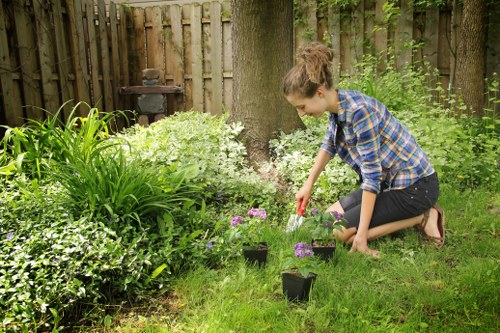Comprehensive Guide to Stump Removal in Tring

Removing a tree stump can be a challenging task for homeowners in Tring. Whether it's for aesthetic reasons, safety concerns, or preparing your yard for new landscaping, effective stump removal is essential.
Understanding the various methods and choosing the right one ensures that the job is done efficiently and safely. This guide covers everything you need to know about stump removal in Tring, offering expert insights and practical advice.
Stump removal involves various techniques, each with its own set of advantages and considerations. From chemical treatments to mechanical removal, homeowners have several options to choose from based on their specific needs and circumstances.
Why Remove a Tree Stump?

Tree stumps left behind after tree removal can pose several problems. They not only mar the appearance of your garden but can also become a hazard over time. Here are some key reasons to consider stump removal:
- Safety: Stumps can be tripping hazards, especially for children and elderly family members.
- Pest Control: Decaying stumps can attract insects, termites, and other pests that may damage your property.
- Space Utilization: Removing a stump frees up space for new plants, lawn areas, or other landscaping projects.
- Prevent Regrowth: Stumps can sometimes sprout new shoots, leading to unwanted tree growth.
By addressing stump removal promptly, you can maintain a safe, beautiful, and functional outdoor space.
Methods of Stump Removal

There are several methods available for stump removal in Tring, each suitable for different situations and budgets. Below, we explore the most common techniques:
1. Grinding
Stump grinding is one of the most popular and effective methods. It involves using a stump grinder machine to chip away the wood below the soil surface.
- Advantages:
- Quick and efficient
- Minimal disturbance to the surrounding area
- Can be used for most types of trees
- Disadvantages:
- Requires specialized equipment
- Can be costly if done professionally
2. Chemical Treatment
Chemical stump removal involves applying chemicals to accelerate the decomposition of the stump. This method is more environmentally friendly but takes longer.
- Advantages:
- Less labor-intensive
- Suitable for smaller stumps
- Eco-friendly options available
- Disadvantages:
- Time-consuming
- Requires careful handling of chemicals
- Not effective for large stumps
3. Manual Removal
Manual removal involves digging out the stump and its roots by hand or with basic tools. This method is labor-intensive but allows for complete removal without chemicals.
- Advantages:
- Complete removal of stump and roots
- No chemicals involved
- Cost-effective for small stumps
- Disadvantages:
- Extremely labor-intensive
- Time-consuming
- Requires physical effort and proper tools
4. Burning
Burning the stump is another method, though it requires caution and adherence to local regulations. This technique is less common but can be effective in dry climates.
- Advantages:
- Reduces the stump to ashes
- Minimal equipment needed
- Disadvantages:
- Regulatory restrictions
- Potential fire hazards
- Environmental concerns
Factors to Consider When Choosing a Stump Removal Method

Selecting the right method for stump removal depends on several factors. Here's what you need to consider:
Size and Type of Stump
Larger stumps with extensive root systems may require mechanical removal or grinding, while smaller stumps might be managed with chemical treatments or manual methods.
Budget
Costs can vary significantly between methods. Grinding and professional removal services tend to be more expensive but offer quick results, whereas manual and chemical methods may be more affordable but take longer.
Timeframe
If you need the stump removed quickly, mechanical methods like grinding are preferable. Chemical methods may take weeks or months to fully decompose the stump.
Environmental Impact
Consider the environmental implications of each method. Chemical treatments should be used responsibly to avoid contamination, while manual removal is more eco-friendly but labor-intensive.
Hiring a Professional Stump Removal Service in Tring

While DIY stump removal is possible, hiring a professional service in Tring can save time and ensure the job is done correctly. Professionals have the right tools and expertise to handle various stump removal methods safely and efficiently.
Benefits of Professional Services
- Expertise: Professionals understand the best methods for different types of stumps and soils.
- Equipment: They have access to advanced tools like stump grinders that are not typically available to homeowners.
- Safety: Removing stumps can be hazardous. Professionals ensure that the process is conducted safely, minimizing risks.
- Efficiency: Professionals can complete the job quickly, allowing you to proceed with other landscaping projects.
Choosing the Right Service
When selecting a stump removal service in Tring, consider the following:
- Reputation: Look for companies with positive reviews and testimonials.
- Experience: Experienced professionals are more likely to handle your stump removal efficiently.
- Cost: Get quotes from multiple services to ensure competitive pricing.
- Insurance: Ensure the company is insured to protect against any potential damage or accidents.
Maintaining Your Yard After Stump Removal
Once the stump is removed, proper maintenance is key to ensuring your yard remains healthy and attractive. Here are some tips:
- Fill the Hole: After removal, fill the hole with soil or gravel to prevent tripping and to prepare the area for new plants.
- Planting: Consider planting grass, flowers, or new trees to enhance the beauty of your yard.
- Mulching: Apply mulch around the area to retain moisture and prevent weed growth.
- Regular Inspection: Keep an eye on the area for any signs of regrowth or pests and address them promptly.
Landscape Design Ideas
Stump removal opens up opportunities for creative landscaping. Here are a few ideas:
- Garden Beds: Create new garden beds where the stump once was to plant a variety of flowers and shrubs.
- Patio Area: Design a patio or seating area to enjoy your outdoor space.
- Pathways: Install pathways to enhance the flow and accessibility of your yard.
- Water Features: Add fountains or ponds to create a relaxing environment.
Local Regulations and Permits in Tring
Before undertaking stump removal, it's important to be aware of any local regulations or permits required in Tring. Compliance ensures that you avoid fines and adhere to environmental standards.
Permits
Some areas may require a permit for large stump removals, especially if it involves heavy machinery or chemical treatments. Check with the local council to determine if you need a permit.
Environmental Considerations
Ensure that your chosen method of stump removal does not negatively impact the local ecosystem. Avoid using harmful chemicals that can contaminate the soil and water sources.
Cost of Stump Removal in Tring
The cost of stump removal varies based on several factors, including the size of the stump, the method chosen, and the accessibility of the site. Here's a general overview:
- Grinding: Typically ranges from £100 to £300, depending on the stump size.
- Chemical Removal: Costs can range from £50 to £150, depending on the treatment required.
- Manual Removal: Usually less expensive, but can vary based on labor intensity, ranging from £80 to £200.
- Burning: Costs are generally lower, but consider potential additional expenses for permits.
Always obtain multiple quotes from local services to ensure you receive a fair price for the work.
Cost-Saving Tips
- DIY Where Possible: If you have the tools and expertise, grinding or manual removal can save on labor costs.
- Combine Services: Some companies offer discounts if you bundle stump removal with other landscaping services.
- Plan Ahead: Scheduling the removal during off-peak seasons may lead to lower prices.
Top 10 Nearby Areas to Tring for Stump Removal Services
Tring is surrounded by several towns and villages where professional stump removal services are readily available. Here are the top 10 nearby areas to consider:
- Welwyn Garden City: Known for its beautifully maintained gardens, offering expert stump removal services.
- Dunstable: A larger town with multiple landscaping companies specializing in stump removal.
- Hemel Hempstead: Offers a range of tree care and stump removal services with experienced professionals.
- Watford: A bustling area with numerous options for stump grinding and removal.
- Rickmansworth: Provides eco-friendly stump removal solutions suitable for residential areas.
- St Albans: Known for its historical gardens, offering specialized stump removal services.
- Little Gaddesden: A quaint village with local experts in manual and chemical stump removal methods.
- Ringwood: Offers comprehensive stump removal services, including grinding and manual extraction.
- Harpenden: Provides high-quality and efficient stump removal services with a focus on customer satisfaction.
- Royston: A nearby town with experienced professionals offering various stump removal techniques.
Choosing a service from these areas ensures you have access to skilled professionals who can handle stump removal effectively, regardless of the method you prefer.
Choosing the Right Equipment for Stump Removal
Having the right tools is crucial for effective stump removal. Whether you're hiring professionals or attempting a DIY approach, understanding the necessary equipment can make the process smoother.
Stump Grinders
Stump grinders are powerful machines designed specifically for cutting away tree stumps below ground level. They are efficient and suitable for most types of stumps.
Chainsaws
Chainsaws are essential for cutting the stump down to ground level before using other removal methods. They are versatile and can be used in various removal techniques.
Digging Tools
For manual removal, tools like shovels, mattocks, and pry bars are necessary to excavate the stump and its roots.
Chemical Treatments
If opting for chemical removal, ensure you have the appropriate chemicals and safety gear. Follow the manufacturer's instructions carefully to avoid environmental harm.
Protective Gear
Safety should always be a priority. Wear protective gear such as gloves, goggles, and sturdy footwear to protect yourself during the removal process.
Safety Tips for Stump Removal
Stump removal can be hazardous if proper safety measures are not followed. Here are important safety tips to keep in mind:
- Wear Protective Gear: Always wear gloves, eye protection, and sturdy footwear to protect against injuries.
- Clear the Area: Remove any obstacles or debris around the stump to prevent accidents.
- Use Equipment Properly: Follow the manufacturer's instructions for any machinery or tools to avoid misuse.
- Be Aware of Underground Utilities: Before digging, ensure there are no underground utilities or pipes that could be damaged.
- Take Your Time: Rushing can lead to mistakes and accidents. Work methodically and carefully.
- Ask for Help: For large stumps, having an extra pair of hands can make the process safer and more manageable.
Environmental Impact of Stump Removal
Stump removal methods can have varying impacts on the environment. Here’s how to minimize negative effects:
Choose Eco-Friendly Methods
Opt for methods like manual removal or natural decomposition processes that do not rely on harmful chemicals. These approaches help preserve soil health and prevent pollution.
Proper Disposal
Ensure that removed stumps and debris are disposed of responsibly. Some services offer recycling options where old wood is repurposed for mulch or other uses.
Promote Biodiversity
Leaving some of the wood in the ground can promote biodiversity, providing habitats for insects and other small creatures. If removing, consider planting new trees or plants to maintain ecological balance.
Prevent Soil Erosion
After stump removal, take steps to prevent soil erosion by planting ground cover or using mulch to stabilize the soil in the area.
Frequently Asked Questions

1. How long does it take to remove a stump?
The time required depends on the method used and the stump's size. Grinding can take a few hours, while chemical treatments may take several weeks to months for complete decomposition.
2. Is it possible to remove a stump myself?
Yes, small stumps can be removed manually or with rented equipment. However, larger stumps often require professional services to ensure safe and effective removal.
3. What are the costs associated with stump removal?
Costs vary based on the method, stump size, and service provider. Generally, stump grinding ranges from £100 to £300, while other methods like chemical removal or manual extraction can be less or more expensive.
4. Can I plant new trees where the stump was removed?
Yes, after removing the stump and filling the area, you can plant new trees or other plants. Ensure the soil is properly prepared to support new growth.
5. Are there any risks involved in stump removal?
Stump removal can involve risks such as equipment accidents, damage to surrounding property, and environmental impacts. Hiring professionals can mitigate these risks by ensuring safe and proper procedures are followed.
Frequently Asked Questions
Our experienced Tring gardeners use a combination of grinding, chemical treatments, and manual removal to effectively eliminate stumps. We choose the best method based on the size and location of the stump, ensuring minimal impact on your garden. Get in touch with our Tring experts for a tailored stump removal solution.
Our stump removal team in Tring has over 10 years of experience maintaining local gardens and estates. Their expertise ensures efficient and safe removal of stumps using the latest techniques and equipment. Trust our seasoned Tring gardeners for reliable stump removal services.
Yes, our Tring stump removal services are fully insured with public liability coverage and our team is certified to handle all necessary equipment and treatments. You can rely on our vetted gardeners for safe and professional stump removal in Tring.
For trusted stump removal services in Tring, contact our locally based team known for their reliability and expertise. We offer comprehensive garden services, including stump removal, hedge trimming, and landscaping. Reach out to our Tring professionals for a free quote today.
Yes, our stump removal services in Tring are competitively priced to offer you the best value without compromising on quality. We provide transparent quotes and flexible options to fit your budget. Contact our Tring team to discuss affordable stump removal solutions.
Our Tring gardeners use advanced equipment such as ride-on stump grinders, eco-friendly chemical treatments, and manual tools for precise stump removal. This ensures efficient and effective service tailored to your garden's needs. Get in touch with our Tring experts for professional stump removal.
Absolutely. We prioritize eco-friendly stump removal in Tring by using sustainable methods and non-toxic treatments to protect your garden and the environment. Our green approach ensures effective stump elimination with minimal ecological impact.
We offer prompt stump removal services in Tring, often scheduling work within a few days of your request. Our efficient team ensures your garden is restored swiftly, minimizing any disruption. Contact our Tring service for timely and dependable stump removal.
Our Tring stump removers are accredited with the British Association of Landscape Industries (BALI) and hold memberships with the Royal Horticultural Society (RHS). These credentials reflect our commitment to high standards and professional excellence in stump removal services.
Yes, our local Tring stump removal experts are highly reliable and dedicated to providing top-notch garden services. With extensive local knowledge and a strong reputation, we ensure your stump removal is handled professionally and efficiently.
We provide seasonal stump removal services in Tring, catering to specific garden needs throughout the year. Whether it's removing stumps in spring lawn preparations or in maintaining gardens during autumn, our Tring team is ready to assist you.
Our stump removal process in Tring prioritizes safety by using certified equipment and following strict safety protocols. Our trained gardeners ensure that the removal is done without harming your garden or posing risks, providing a secure and clean finish.




